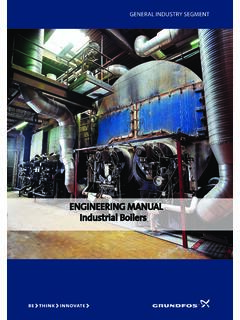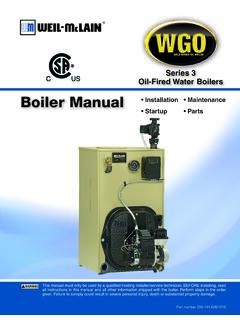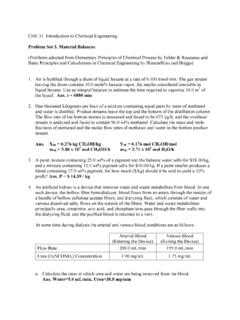Transcription of Sulfites for Oxygen Control - Scranton Associates
1 If you would like a more detailed version of this report, please request SOS along with your e-mail address. Sulfites for Oxygen Control Robert R. Cavano Scranton Associates , Incorporated A. Introduction Oxygen is present in all water supplies, though at widely varying concentrations. Unless limited, it can cause corrosion throughout the entire steam generation system. In addition to weakening the metal, this attack generates metallic oxides that become or form troublesome deposits. And while Oxygen provides a major pitting challenge on its own, additional forms of corrosion are accelerated by its presence. Carbon dioxide reduces the pH of the condensate causing grooving and generalized thinning of piping. It is well known, moreover, that Oxygen and carbon dioxide are synergistic in their activity to increase corrosion. Oxygen dissipation and deactivation are the most common methods of Control , carried out by mechanical or chemical means or by a combination of the two.
2 Other popular methods of protecting the metal in a boiler are passivation and filming inhibitors. The most common chemical scavengers, by far, are based on Sulfites and bisulfites, an approach that can be highly effective if boiler pressures are not too high, and total solids are kept within prescribed limits. B. Oxygen Corrosion Corrosion is primarily a phenomenon in which the metal surface hosts a network of galvanic cells. In the presence of water , there is a tendency for ions to go into solution at the anode, resulting in hydrogen being released at the cathode. This creates an electrochemical potential which promotes iron corrosion. When sufficient Oxygen is present, these reactions are accelerated in a process described as depolarization. In the absence of adequate scavenging, the various forms of iron oxide are converted to hematite.
3 Pitting is an especially distressing condition which quickly destroys the integrity of a metal. Within a pit, iron contributes to reactions that form black iron oxide. If the process were to stop here, the coating could provide good protection. But the process goes on with a continuing formation of ferric hydroxide. As the temperature of the water rises, more Oxygen leaves the solution, no equilibrium is reached or magnetic coating formed, and corrosion continues until the Oxygen is exhausted. 1 SOC - 09/13/07 C. Sources of Oxygen A major obstacle in planning any boiler treatment program is the difficulty of estimating the Oxygen present in a system or being added with the make up. Temperature is an especially critical factor. Since Oxygen is not an ionizable gas, its solubility is much more temperature dependent than is carbon dioxide.
4 Low temperature make up water contains as much as 10 mg/L of Oxygen and hot feedwater about 3 mg/L. A variation from 40 F to 80 F in our water source results in a drop in Oxygen content from 13 ppm to 8 ppm. Concentrations of Oxygen are usually expressed as cubic centimeters per liter (cc/L) or milliliters per liter (ml/L) [numerically the same]. Oxygen may also be reported by weight: 1 cc/L or ml/L of dissolved Oxygen equals mg/L. 1 mg/L of Oxygen then equals cc/L (or ml/L). D. Oxygen Limits Even very low levels of Oxygen can cause corrosion. Table I shows the concentrations which must be complied with in deaerated water if corrosion to steel is to be avoided: Table I Oxygen Limits (mg/L) Type of water Maximum Oxygen Concentration (mg/L) Cold water Hot water Low Pressure Boilers (<250 psi) High Pressure Boilers Another set of upper limits for corrosion prevention has been established by the American boiler Manufacturer Association (ABMA): Table II Oxygen Limits in Boilers Drum Operating Pressure (psig) 0 450 451 - 900 Dissolved Oxygen (mg/L) < < E.
5 Deaeration Efficient deaeration is necessary to minimize boiler and condensate corrosion. Mechanical deaeration ordinarily reduces Oxygen to a residual of less than mg/L. In a multistage deaerator, the amount of Oxygen can be further reduced to mg/L or less. Since the maximum Oxygen content of higher pressure boilers should be between and ppm (as mg/L), both deaeration and chemical treatment are usually necessary. 2 SOC - 09/13/07 F. Sulfite treatment Since it is not possible to remove all dissolved Oxygen by physical means, traces of it usually still remain, and no matter how small they are, cause significant corrosion unless chemical agents are introduced. This Oxygen may be controlled by feeding sodium sulfite in quantities sufficient to react with the Oxygen and, in addition, adding enough to constitute a comfortable excess.
6 The Sulfites (whether sulfite or bisulfite, sodium or potassium) have become, because of their low cost, the first choice for scavenging. Sodium sulfite is sold as a powder -- as is, catalyzed, or decharacterized. Liquid versions are often available as aqueous sodium sulfite or metabisulfite solutions. Products based on sulfite react with Oxygen to form sodium sulfate. Solids introduced through this reaction can become a problem as pressures go up, so the use of sulfite is limited to lower pressure installations. The sulfite/ Oxygen reaction is inhibited by chelants, by contaminants in the feed water , or by treatment chemicals. Users of sodium sulfite often express concern with its slow and incomplete solubility. Realizing that metabisulfite is more readily soluble (38% @ about 43 F), many have used that alternative. Several suppliers now mix metabisulfite with sulfite to lower the pH and improve the solubility of the sulfite and possibly of the catalyst.
7 G. Sulfite Dosage The amount of Oxygen scavenger required in a boiler water is related to the concentration of dissolved Oxygen , the residual level of scavenger specified, and the percent of blow down performed. water temperature, water composition, and reaction time also have considerable impact on the ultimate quantity of scavenging chemical needed: 252/32 = parts pure sodium sulfite per part Oxygen by weight; 190/32 = parts of metabisulfite [becomes bisulfite in water ] per part of Oxygen by weight; = (adjustment for activity of commercial sodium sulfite); x = parts sulfite when Oxygen is stated as parts per unit volume; (252 + 32)/(32)( ) = parts sulfate created per part of Oxygen . Sulfite dosage figures can alternatively be developed as: 1 ml/L dissolved Oxygen = mg/L (or lbs Oxygen /million lbs water ) [ x = ]. This requires lbs of sodium sulfite/million pounds of water [ x = ], or lbs of sodium sulfite/million gallons of water [ x = ].
8 3 SOC - 09/13/07 Praise the Lord who allows us to convert from among the various sources of sulfite: Table III Sulfite Conversions If dosage is stated as 100 mg/L of sodium sulfite, we may use 75 mg/L of metabisulfite If 100 mg/L of sulfur trioxide is called for 157 mg/L of sodium sulfite may be substituted. Sodium Sulfite (Na2SO3) 100 133 157 197 Sodium Metabisulfite (Na2S2O5)75 100 119 148 Sulfur Trioxide (SO3) 63 84 100 124 Sulfur Dioxide (SO2) 51 68 80 100 H. Speed of Reaction For good corrosion Control in a boiler , rapid reaction is sought between Oxygen and the chemical scavenger. A slow reaction rate could allow traces of Oxygen to enter the boiler even in the presence of an excess of sodium sulfite.
9 Factors determining the rate at which this reaction takes place are: the purity of the water , the residence time in a system, the location of the chemical feed , the levels of dosage, the temperature of the water , its pH, and the presence and concentration of catalysts. The performance of sodium sulfite is very sensitive to catalysis from trace amounts of manganese, copper, iron, nickel, or cobalt. The sulfite/ Oxygen reaction is known to be inhibited by some alcohols, phenols, amines, and thiosulfate. Other contaminants or organic treatment chemical such as corrosion inhibitors, scale inhibitors, and biocides may also slow down reaction time. A slow reaction can present a problem at early phases in a system and require the use of catalysts or feeding techniques that provide maximum time for the reaction to occur. The reaction rate for sulfite appears to be the fastest of all of the scavengers, followed by erythorbic acid and DEHA.
10 Slower rates, in general, have been reported for hydroquinone, carbohydrazide, and hydrazine. I. Catalyzation A catalyst is defined as a substance that changes a reaction rate without being consumed in the process. In some smaller systems, stray metals may perform as sulfite catalysts. Rarely is the amount of iron or copper arising from contamination or corrosion sufficient to catalyze sulfite in larger systems. In addition, the presence of large quantities of these metals may be undesirable because of the potential for iron or cobalt poisoning of polymers and the risk of copper plating out on metal surfaces, and may have to be removed. Erythorbates have been widely used as anti-oxidants for food products. They are able to reduce stray metals, sequester them, and maintain them in a system thereby preventing oxidation and precipitation.










